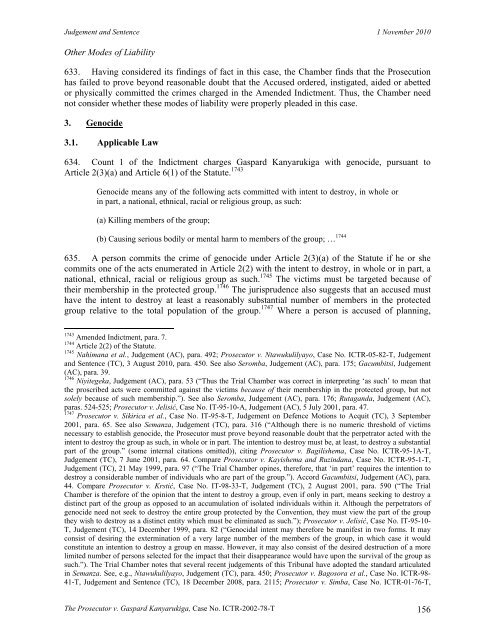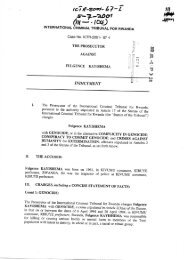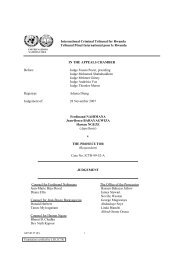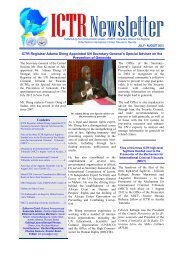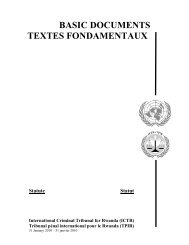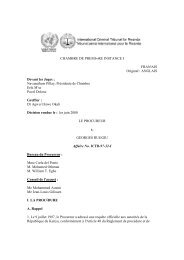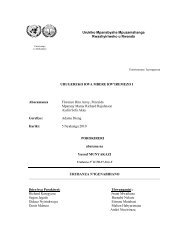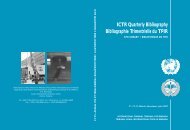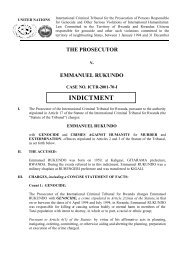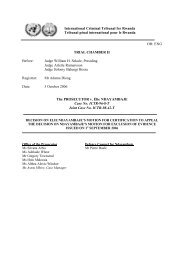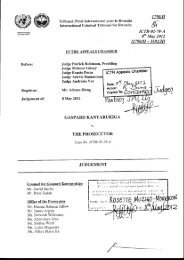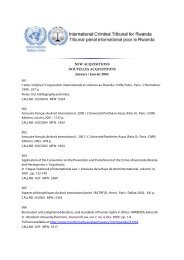Kanyarukiga - JUDGEMENT AND SENTENCE - Refworld
Kanyarukiga - JUDGEMENT AND SENTENCE - Refworld
Kanyarukiga - JUDGEMENT AND SENTENCE - Refworld
Create successful ePaper yourself
Turn your PDF publications into a flip-book with our unique Google optimized e-Paper software.
Judgement and Sentence 1 November 2010<br />
Other Modes of Liability<br />
633. Having considered its findings of fact in this case, the Chamber finds that the Prosecution<br />
has failed to prove beyond reasonable doubt that the Accused ordered, instigated, aided or abetted<br />
or physically committed the crimes charged in the Amended Indictment. Thus, the Chamber need<br />
not consider whether these modes of liability were properly pleaded in this case.<br />
3. Genocide<br />
3.1. Applicable Law<br />
634. Count 1 of the Indictment charges Gaspard <strong>Kanyarukiga</strong> with genocide, pursuant to<br />
Article 2(3)(a) and Article 6(1) of the Statute. 1743<br />
Genocide means any of the following acts committed with intent to destroy, in whole or<br />
in part, a national, ethnical, racial or religious group, as such:<br />
(a) Killing members of the group;<br />
(b) Causing serious bodily or mental harm to members of the group; … 1744<br />
635. A person commits the crime of genocide under Article 2(3)(a) of the Statute if he or she<br />
commits one of the acts enumerated in Article 2(2) with the intent to destroy, in whole or in part, a<br />
national, ethnical, racial or religious group as such. 1745 The victims must be targeted because of<br />
their membership in the protected group. 1746 The jurisprudence also suggests that an accused must<br />
have the intent to destroy at least a reasonably substantial number of members in the protected<br />
group relative to the total population of the group. 1747 Where a person is accused of planning,<br />
1743 Amended Indictment, para. 7.<br />
1744 Article 2(2) of the Statute.<br />
1745 Nahimana et al., Judgement (AC), para. 492; Prosecutor v. Ntawukulilyayo, Case No. ICTR-05-82-T, Judgement<br />
and Sentence (TC), 3 August 2010, para. 450. See also Seromba, Judgement (AC), para. 175; Gacumbitsi, Judgement<br />
(AC), para. 39.<br />
1746 Niyitegeka, Judgement (AC), para. 53 (“Thus the Trial Chamber was correct in interpreting ‘as such’ to mean that<br />
the proscribed acts were committed against the victims because of their membership in the protected group, but not<br />
solely because of such membership.”). See also Seromba, Judgement (AC), para. 176; Rutaganda, Judgement (AC),<br />
paras. 524-525; Prosecutor v. Jelisić, Case No. IT-95-10-A, Judgement (AC), 5 July 2001, para. 47.<br />
1747 Prosecutor v. Sikirica et al., Case No. IT-95-8-T, Judgement on Defence Motions to Acquit (TC), 3 September<br />
2001, para. 65. See also Semanza, Judgement (TC), para. 316 (“Although there is no numeric threshold of victims<br />
necessary to establish genocide, the Prosecutor must prove beyond reasonable doubt that the perpetrator acted with the<br />
intent to destroy the group as such, in whole or in part. The intention to destroy must be, at least, to destroy a substantial<br />
part of the group.” (some internal citations omitted)), citing Prosecutor v. Bagilishema, Case No. ICTR-95-1A-T,<br />
Judgement (TC), 7 June 2001, para. 64. Compare Prosecutor v. Kayishema and Ruzindana, Case No. ICTR-95-1-T,<br />
Judgement (TC), 21 May 1999, para. 97 (“The Trial Chamber opines, therefore, that ‘in part’ requires the intention to<br />
destroy a considerable number of individuals who are part of the group.”). Accord Gacumbitsi, Judgement (AC), para.<br />
44. Compare Prosecutor v. Krstić, Case No. IT-98-33-T, Judgement (TC), 2 August 2001, para. 590 (“The Trial<br />
Chamber is therefore of the opinion that the intent to destroy a group, even if only in part, means seeking to destroy a<br />
distinct part of the group as opposed to an accumulation of isolated individuals within it. Although the perpetrators of<br />
genocide need not seek to destroy the entire group protected by the Convention, they must view the part of the group<br />
they wish to destroy as a distinct entity which must be eliminated as such.”); Prosecutor v. Jelisić, Case No. IT-95-10-<br />
T, Judgement (TC), 14 December 1999, para. 82 (“Genocidal intent may therefore be manifest in two forms. It may<br />
consist of desiring the extermination of a very large number of the members of the group, in which case it would<br />
constitute an intention to destroy a group en masse. However, it may also consist of the desired destruction of a more<br />
limited number of persons selected for the impact that their disappearance would have upon the survival of the group as<br />
such.”). The Trial Chamber notes that several recent judgements of this Tribunal have adopted the standard articulated<br />
in Semanza. See, e.g., Ntawukulilyayo, Judgement (TC), para. 450; Prosecutor v. Bagosora et al., Case No. ICTR-98-<br />
41-T, Judgement and Sentence (TC), 18 December 2008, para. 2115; Prosecutor v. Simba, Case No. ICTR-01-76-T,<br />
The Prosecutor v. Gaspard <strong>Kanyarukiga</strong>, Case No. ICTR-2002-78-T 156


